语料库戏剧翻译文体学任晓霏,冯庆华共43页
- 格式:ppt
- 大小:4.88 MB
- 文档页数:43
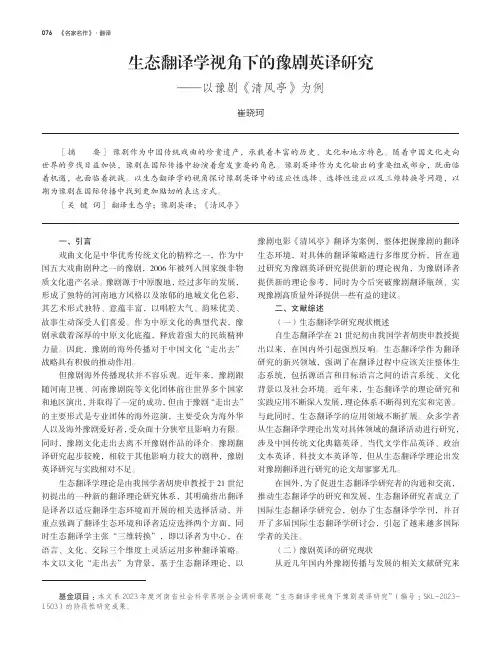
076《名家名作》·翻译[摘 要] 豫剧作为中国传统戏曲的珍贵遗产,承载着丰富的历史、文化和地方特色。
随着中国文化走向世界的步伐日益加快,豫剧在国际传播中扮演着愈发重要的角色。
豫剧英译作为文化输出的重要组成部分,既面临着机遇,也面临着挑战。
以生态翻译学的视角探讨豫剧英译中的适应性选择、选择性适应以及三维转换等问题,以期为豫剧在国际传播中找到更加贴切的表达方式。
[关 键 词] 翻译生态学;豫剧英译;《清风亭》生态翻译学视角下的豫剧英译研究——以豫剧《清风亭》为例崔晓珂一、引言戏曲文化是中华优秀传统文化的精粹之一,作为中国五大戏曲剧种之一的豫剧,2006年被列入国家级非物质文化遗产名录。
豫剧源于中原腹地,经过多年的发展,形成了独特的河南地方风格以及浓郁的地域文化色彩,其艺术形式独特、意蕴丰富,以唱腔大气、韵味优美、故事生动深受人们喜爱。
作为中原文化的典型代表,豫剧承载着深厚的中原文化底蕴,释放着强大的民族精神力量。
因此,豫剧的海外传播对于中国文化“走出去”战略具有积极的推动作用。
但豫剧海外传播现状并不容乐观。
近年来,豫剧跟随河南卫视、河南豫剧院等文化团体前往世界多个国家和地区演出,并取得了一定的成功,但由于豫剧“走出去”的主要形式是专业团体的海外巡演,主要受众为海外华人以及海外豫剧爱好者,受众面十分狭窄且影响力有限。
同时,豫剧文化走出去离不开豫剧作品的译介。
豫剧翻译研究起步较晚,相较于其他影响力较大的剧种,豫剧英译研究与实践相对不足。
生态翻译学理论是由我国学者胡庚申教授于21世纪初提出的一种新的翻译理论研究体系,其明确指出翻译是译者以适应翻译生态环境而开展的相关选择活动,并重点强调了翻译生态环境和译者适应选择两个方面,同时生态翻译学主张“三维转换”,即以译者为中心,在语言、文化、交际三个维度上灵活运用多种翻译策略。
本文以文化“走出去”为背景,基于生态翻译理论,以豫剧电影《清风亭》翻译为案例,整体把握豫剧的翻译生态环境,对具体的翻译策略进行多维度分析,旨在通过研究为豫剧英译研究提供新的理论视角,为豫剧译者提供新的理论参考,同时为今后突破豫剧翻译瓶颈、实现豫剧高质量外译提供一些有益的建议。
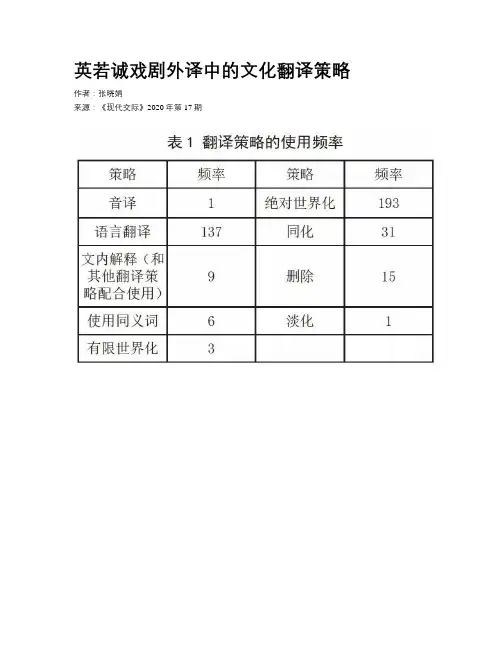
英若诚戏剧外译中的文化翻译策略作者:张晓娟来源:《现代交际》2020年第17期摘要:以英若诚所译的《狗儿爷涅槃》汉英对照本为语料建立汉英平行语料库,对该戏剧译本中的物质文化、社会文化、语言文化这三类文化专有项进行翻译策略的考察和统计分析,研究发现英若诚在文化翻译中总体以语言翻译策略和绝对世界化策略为主,其他策略为补充,但三类文化翻译采取的策略存在明显差异:按照物质文化、社会文化、语言文化的顺序,语言翻译策略的使用逐渐减少,绝对世界化策略的使用逐渐增多。
分析英若诚戏剧译本中的文化翻译策略能为中国戏剧的外译和传播提供有价值的参考和借鉴。
关键词:英若诚文化翻译文化专有项平行语料库中图分类号:H315 ;文献标识码:A ;文章编号:1009-5349(2020)17-0069-04巴斯奈特(1985)认为戏剧翻译是一项不可能完成的任务。
因为以演出为目的的戏剧翻译,不仅要照顾一般语际翻译中的语言因素,还要考虑其他非语言因素,如戏剧表演的时空限制及观众的接受度等[1]。
成功的戏剧译本,必定是经过演出实践的打磨。
集导演、演员、译者于一身的英若诚在戏剧翻译中具有天然优势,他在戏剧翻译和演出实践中,形成了自己独特的翻译风格,翻译了近20部剧本,出版了《英若诚名剧译丛》,成为戏剧“演出本”翻译的典范。
《狗儿爷涅槃》是《英若诚名剧译丛》中的三部中国话剧之一,也是中国当代剧坛最成熟的剧作之一,讲述了中国农村的变迁和一位普通农民——狗儿爷的命運。
1995年英若诚将其译成英语,在美国百老汇上演。
该剧具有大量的中国文化元素,呈现了那个时代中国文化的特殊性。
英若诚凭借扎实的语言功底和丰富的舞台经验,成功地翻译了这些文化因素,并使其具备了舞台所需的“可表演性”。
一、文化与翻译翻译是一种跨文化的交际活动。
译者面临的最大挑战就是如何将源语文化中独有的元素传递到译语文化中。
1990年,翻译的文化学派代表人物巴斯奈特和勒弗维尔首次提出了“翻译的文化转向”这一口号。
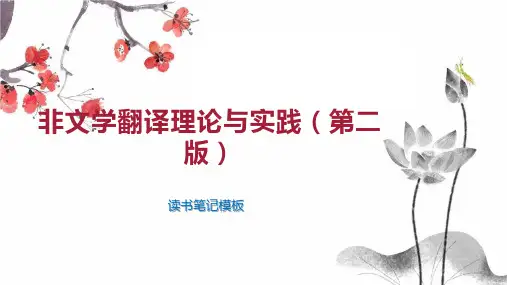
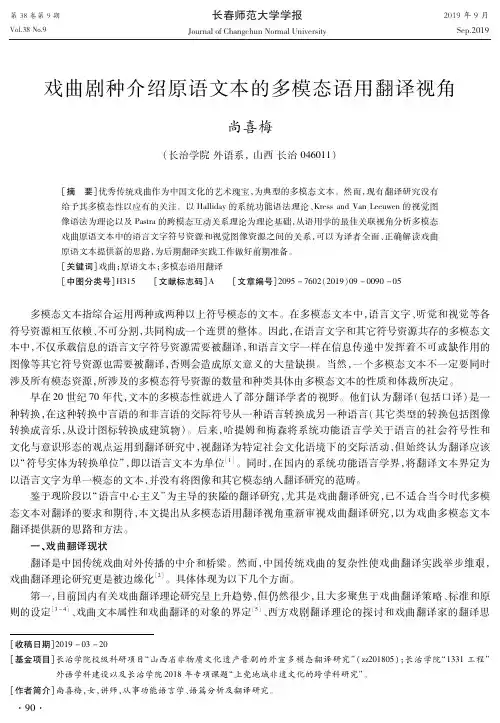
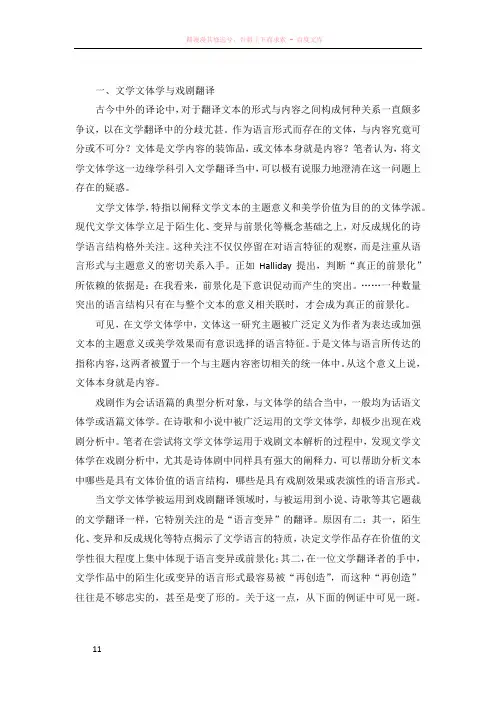
一、文学文体学与戏剧翻译古今中外的译论中,对于翻译文本的形式与内容之间构成何种关系一直颇多争议,以在文学翻译中的分歧尤甚。
作为语言形式而存在的文体,与内容究竟可分或不可分?文体是文学内容的装饰品,或文体本身就是内容?笔者认为,将文学文体学这一边缘学科引入文学翻译当中,可以极有说服力地澄清在这一问题上存在的疑惑。
文学文体学,特指以阐释文学文本的主题意义和美学价值为目的的文体学派。
现代文学文体学立足于陌生化、变异与前景化等概念基础之上,对反成规化的诗学语言结构格外关注。
这种关注不仅仅停留在对语言特征的观察,而是注重从语言形式与主题意义的密切关系入手。
正如Halliday提出,判断“真正的前景化”所依赖的依据是:在我看来,前景化是下意识促动而产生的突出。
……一种数量突出的语言结构只有在与整个文本的意义相关联时,才会成为真正的前景化。
可见,在文学文体学中,文体这一研究主题被广泛定义为作者为表达或加强文本的主题意义或美学效果而有意识选择的语言特征。
于是文体与语言所传达的指称内容,这两者被置于一个与主题内容密切相关的统一体中。
从这个意义上说,文体本身就是内容。
戏剧作为会话语篇的典型分析对象,与文体学的结合当中,一般均为话语文体学或语篇文体学。
在诗歌和小说中被广泛运用的文学文体学,却极少出现在戏剧分析中。
笔者在尝试将文学文体学运用于戏剧文本解析的过程中,发现文学文体学在戏剧分析中,尤其是诗体剧中同样具有强大的阐释力,可以帮助分析文本中哪些是具有文体价值的语言结构,哪些是具有戏剧效果或表演性的语言形式。
当文学文体学被运用到戏剧翻译领域时,与被运用到小说、诗歌等其它题裁的文学翻译一样,它特别关注的是“语言变异”的翻译。
原因有二:其一,陌生化、变异和反成规化等特点揭示了文学语言的特质,决定文学作品存在价值的文学性很大程度上集中体现于语言变异或前景化;其二,在一位文学翻译者的手中,文学作品中的陌生化或变异的语言形式最容易被“再创造”,而这种“再创造”往往是不够忠实的,甚至是变了形的。
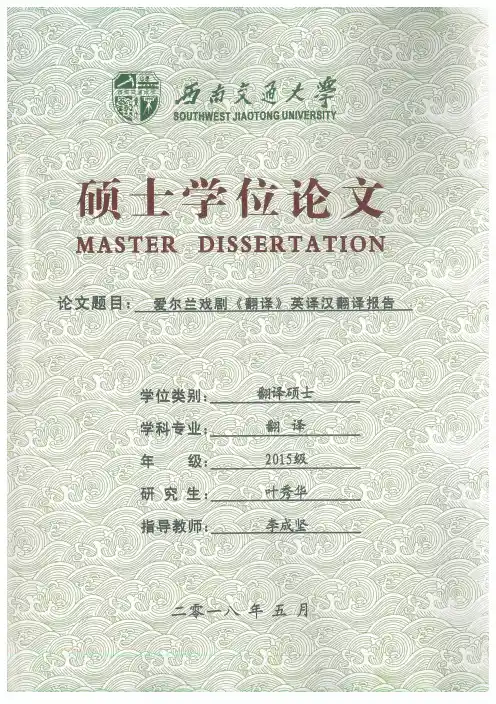
摘要本文是一篇关于关于将爱尔兰戏剧《翻译》汉译成适合广大中国读者阅读的中文译本的翻译实践报告。
在当前英国脱欧的历史背景下,爱尔兰和北爱尔兰的边境问题成为当下国际社会密切关注的一个时事热点。
而爱尔兰戏剧《翻译》讲述了19世纪80年代一批英国皇家工程兵受英国政府派遣,在多尼戈尔郡的一个爱尔兰语社区进行地貌测绘,并将爱尔兰语地名全部翻译为英语地名的殖民史实。
通过阅读《翻译》,读者可以了解到爱尔兰19世纪的这段被大英帝国殖民统治的历史,有助于理解当前英国脱欧背景下爱尔兰热点问题的历史缘由。
在翻译剧本《翻译》之前,译者做了译前准备工作,针对剧本中的理解难点进行了分析,通过查询有关文献,发现剧本中影响译者和读者理解的很多词汇都属于文化专有项的范畴。
译者根据艾克西拉和诺德关于文化专有项的定义以及纽马克关于文化专有项的分类方法对戏剧《翻译》里出现的文化专有项进行了归类,将戏剧中出现的文化专有项分为三大类别,即地理生态,物质文化和组织机构。
然后根据戴维斯提出的七种翻译策略,以举例分析的方式阐述了译者如何利用这七种策略进行翻译实践。
接着通过举例分析了戏剧《翻译》中三大类别的文化专有项的翻译思路及其对应翻译策略。
综上所述,本文从文化专有项的翻译策略和思路来分析了爱尔兰戏剧《翻译》的翻译过程,为后面的译者在戏剧翻译方面提供了一种参考方法。
关键词:《翻译》;爱尔兰戏剧;布莱恩·弗里尔;文化专有项;AbstractThis is a translation report on the English-Chinese translation of the Irish drama Translations, which analyzes how the translator translated this drama into a target text in simplified Chinese that is readable for ordinary Chinese readers. In the context of Brexit, the Ireland border issue is currently an international hot topic that has attracted attention across the globe. The Irish drama Translations tells about h er Majestey‘s Government sending a group of royal engineers to County Donegal in Ireland to carry out the ordnance survey of this area and change all the geographic names of this county into anglicized and standardized versions in the 1880s. (Qi Yaping 2010:119) By reading Translations, readers can gain an overview on Britain‘s colonization of Ireland i n this period, which helps them understand the historical causes of the Ireland border issues.Before starting the translation task, the author made many pre-translation preparations. By studying the source text, the author found most of the unreadable terms belong to Culture-specific Items. Based on the definition of Culture-specific Items by Aixelá and Nord, as well as the classification method by Newmark, the author classified the Culture-specific Items in Translations into three main categories, ecology, material culture and organizations. By studying the seven translation methods proposed by Davies, the author analyzed each translation strategy through case studies. Then the author analyzed the translation of the three categories of Culture-specific Items in drama Translations and relevant translation strategies employed. Above all, the author of this report explored the translation of Irish drama Translations from the perspective of Culture-specific Items, which could provide later translators a reference on drama translation.Keywords:Translations; Ireland Drama; Brian Friel; Culture-specific Items;CONTENTSCHAPTER ONE INTRODUCTION (1)1.1 Brief Introduction to the Translation Task (1)1.2 Target Readers and Requirements of the Client (2)1.2.1 The Target Readers (2)1.2.2 Requirements Proposed by the Client (2)1.3 Purpose and Significance of the Translation Task (3)CHAPTER TWO PRE-TRANSLATION (4)2.1 Convert Format of the Source Text (4)2.2 Analysis of the Source Text (7)2.2.1 Historical Background of the Drama Translations (7)2.2.2 Plot and Characters of the Drama Translations (7)2.2.3 Lexical Features of the Source Text (9)2.2.4 Syntactical Features of the Source Text (10)2.3 Culture-specific Items and Their Translation Strategies (11)2.3.1 Definition of the Culture-specific Items (12)2.3.2 Division of Culture-specific Items (13)2.3.3 Translation Strategies and Methods (14)CHAPTER THREE THE TRANSLATION PROCESS (22)3.1 Translation of the Culture-specific Items on Ecology (22)3.2 Translation of the Culture-specific Items on Material Culture (23)3.3 Translation of the Culture-specific Items on Organizations Terms (25)3.3.1 Translation of Religious terms (25)3.3.2 Translation of Administrative Terms (26)3.4 Summary (27)CAPTER FOUR POST-TRANSLATION (28)CONCLUSION (29)BIBLIOGRAPHY (30)ACKNOWLEDGEMENTS (33)Appendix (34)CHAPTER ONE INTRODUCTION1.1 Brief Introduction to the Translation TaskSince the late 19th century, Irish drama has played an important role in modern theatre literature in the transmission of ideas and ideology. In the 1960s, the famous Irish playwright Brian Friel emerged with his well-known Field Day Theatre Company. Both audience and critics rapidly acknowledged his dramas. Among his acclaimed dramas, Translations is a typical drama that focuses on language and communication, with its theme concerning the relationship between language, identity, politics, history and religion. (Castro, 2013) In order to introduce this drama to Chinese readers, Professor Li Chenjian entrusted the translation task of Translations to author of the report in 2016. Translating this drama from English to Chinese is an attempt to bring Chinese readers a new vision of Irish society in the 19th century. It is also the first time this drama has been translated into Chinese.To complete this translation project, the author of this report needs to complete the following tasks:1) convert the source text from pictures of JPG format into a whole WORD document;2) edit the converted source text to prepare it for translating;3) explore the historical background and playwright‘s creat ion ideas of this drama;4) pre-read the whole text to get an overview of the language features as well as difficult sentences;5) upload the prepared source text to the online translation software Jeemaa and completing the translation process;6) review and revise the translated target text in the online database;7) export the first draft of the translation;8) add footnotes to some difficult words and sentences;9) discuss with Professor Li about the words and sentences that need to be revised;10) revise the target text according to the discussion and read through the revised text to finalize the translation.1.2 Target Readers and Requirements of the ClientBefore starting this translation task, the report author carefully studied the requirements of Professor Li as well as the target readers and previewed the source text of the translation task in order to select proper translation strategies and translation methods accordingly.1.2.1 The Target ReadersAccording to Professor Li, the target readers are general Chinese readers who are interested in theatre literature but tend to, or can only, read Chinese books. As there is no plan to stage this drama in China so far, the performability of the target text is not considered here. That is, the actors or performers of this drama are not included in the target readers. This decides the purpose of the translation task, which is to provide the ordinary Chinese readers an Ireland drama in Chinese for reading. Therefore, this translation purpose helps to select proper translation methods accordingly.Based on our current education syllabus, ordinary readers who have completed their high school education could have the ability to appreciate a drama, either on stage or on the page. However, not everyone who completed high school education is familiar with Irish History or Culture. To provide readers an accessible translation, footnotes should be added to some Culture-specific Items in the target text.1.2.2 Requirements Proposed by the ClientTo achieve a better translation of this drama, Professor Li has proposed some requirements for the target text. The requirements are as follows:1)The source text should be the authoritative version of Translations as given in theformat of JPG.2)The layout of the target text should be consistent with that of the source text.3)The language of the target texts shall be plain and simple Chinese.4)The target text should be suitable for reading rather than staging.5)Footnotes should be added to some Culture-loaded words or sentences.6)The finalized version of this translation task should be ready for printing.1.3 Purpose and Significance of the Translation TaskAccording to the demands of the target readers and the translation requirements by Professor Li, the purpose of this task is to provide the Chinese readers a Chinese version of the Ireland drama Translations.By reading Translations, the Chinese readers can gain an overview of Irish society in the 19th century. As the target text language is plain and smooth simple Chinese, general readers can read it as either a literary story or a historical legend. In the context of Brexit, reading this drama can also provide readers a historical view for the current Ireland border issues.On the other hand, the target text of this drama can also provide other translators with a reference for drama translation. During the translation process, the translator has made great efforts to translate the Culture-specific items in the source text. Davies‘ translation strategies are employed to make the translation more accurate and readable. This kind of target reader-oriented translation is also a good example for similar drama translation in the future.Besides, the author also learnt a lot on the translation strategies of drama translation during the translation process of this drama, as well as the connection between translation and culture studies, which is worth a further study.CHAPTER TWO PRE-TRANSLATIONAs mentioned before, this is the first time this drama has been translated into Chinese. Neither print nor electronic versions of this drama can be obtained in China. The source text provided by the client are pictures of the original drama in JPEG format. To start this translation task, several steps are required, including transforming the source text of Translations into an editable WORD document from these JPG format pictures, analyze the source text and select proper translation strategies and methods.2.1 Convert Format of the Source TextThe original source text is a file of pictures of the Translations in the JPG format. Just as shown in Fig. 2.1 a), it is non-editable. Therefore, the pictures should be converted into an editable WORD document first. A software named ABBYY was applied here.Fig. 2.1 a) one picture of the Translations in the JPG format After converting, the words in the pictures were kept in a WORD document. Then the WORD document was exported from the ABBYY. But the layout of the exported text was not the same as the original copy. There were mistakes in spelling, extra punctuation marks andsentences with missing words, as is shown in Fig. 2.1 b).Fig. 2.1 b) exported text in the WORD documentThe next step is to edit the exported text, correct spelling mistakes and add missing words according to the original pictures of the drama text. After that, the format of the revised text should also be reset to make it consistent with that of the source text. Then the text is ready for translation. As is shown in Fig.2.1 c), the layout of source text is now the same as it is in the original book.Fig. 2.1 c) reset source text that is ready for translation During the pre-processing of the source text, all the editing and typing should be carefully carried out according to the JPG format pictures. When it is completed, the first copy of this processed source text should also be checked sentence by sentence according to the original copy for several times to ensure it is accurate. After several proof readings untilalmost no mistake can be tracked, the source text is ready for translation. The next step is analyzing the source text.2.2 Analysis of the Source TextAs one of Brian Friel‘s representative dramatic works, Translations tells a story that happened in Baile Beag in County Donegal in Ireland in August 1833, which is based on actual historical events. To prepare for the translation task, an analysis of this drama is conducted on its historical background, plot and characters as well as its language features.2.2.1 Historical Background of the Drama TranslationsIn 1824, the British Parliament produced the first Ordnance Survey map of Ireland, which was intended to map and replace every Gaelic name by a translated English equivalent, or a comparable-sounding one in English. At the same time, the educational system in Ireland began a significant transformation. Gradually, all local Irish-speaking schools (the hedge schools) were replaced with national schools where English became the only language of instruction. Through this reform, the British clearly aimed to anglicize, or possibly even ―civilize‖ the Irish population. They also had more practical purposes, of course: taxation, penetration, and ultimately, domination (Reinares & Barberan, 2007:9)2.2.2 Plot and Characters of the Drama TranslationsBefore introducing the plot, profiles of the main characters are listed as follows according to their introduction in the drama. The introduction of the characters helps the reader to gain a quicker and better understanding of the drama plot. Therefore, this part should also be added to the target text as a reference.2.2.2.1 Introductions of the Main CharactersName IntroductionHugh The headmaster of a small hedge school housed in an old barn. He frequently drinks a large amount, but he is by no means drunk. (Brian Friel, 1996: 397) He isa consummate Irish storyteller and educator. He appears egocentric, but isabsolutely charming and astute.Manus Hugh‘s older son, Manus serves as his father‘s unpaid assistant at the hedge school, though he frequently takes the class because of his father‘s drinkinghabits. He is searching for a headmaster position of his own.Owen Hugh‘s younger son. He is now working in the English Army, as a part-time, underpaid, civilian interpreter. His job is to ―translate the quaint, archaic tongueyou people persist in speaking into the King‘s good English‖. (Brian Friel, 1996:404)Maire Manus‘s fiancée, a strong-minded and adventurous woman. (Brian Friel, 1996: 387) She wants to learn English. She is also heroine of the love triangle Manusand is involved in a romantic relationship with Manus and the Lieutenant.Lieutenant Yolland A British soldier working with Owen on the renaming of the Donegal countryside for the Ordnance Survey. Though he does not speak Gaelic, he is fascinated with the Irish countryside and fantasizes about settling down in Baile Beag. His disappearance at the end of this drama brings the drama to a climax.Captain Lancey Lieutenant Yolland‘s commanding officer. Lancey is the British captain leading the local Ordnance Survey efforts.Sarah A student in the hedge school, she has such a serious speech defect that she is considered dumb. (Brian Friel, 1996: 383) Only Manus sees her potential andteaches her slowly, painstakingly, to speak. She lives with an intensity borne ofthe need and inability to communicate.Jimmy Jack Known as the ―Infant Prodigy,‖ Jimmy Jack is a perpetual bachelor in his sixties.He lives in one set of clothes and rarely washes. Eccentric and benignly mad, heis fluent in Greek and Latin. He lives alone and comes to evening classes at thehedge school partly for the company, and partly for the intellectual stimulation.(Brian Friel, 1996: 383)Doalty An open-minded, open-hearted, generous and slightly thick young man. (Brian Friel, 1996: 389-390)Bridget A fresh young girl, ready to laugh, vain, and with a country woman‘s instinctive cunning. (Brian Friel, 1996: 390)Table 2.2.1 Main characters2.2.2.2 Plot of the TranslationsThe drama Translations was set in a hedge-school in the small town of Baile Beag, an Irish speaking community in County Donegal in the summer of 1833. Hugh O'Donnell was the headmaster of a hedge school, a kind of rural school in Ireland that provides basiceducation to farm families. Manus, Hugh's older son, helped his father to teach in the hedge-school. Hugh insisted on teaching in Irish, even though he knew that their language Gaelic would inevitably be replaced by English. Owen was Hugh‘s younger son, who came back to the town with the Royal Engineers, Captain Lancey and Lieutenant Yolland, who were sent to Baile Beag by the government to remap the Irish countryside and change place names into anglicized and standardized versions. One of the engineers, Lieutenant Yolland was then captivated by Irish culture and believes the work they were doing was an act of destruction. Besides this, a love triangle developed among Manus, Yolland and Maire, a strong-minded and adventurous woman in the village. Yolland disappeared mysteriously, and Manus left town, broken-hearted. Owen realized he must remain true to his roots and decided to join the Irish resistance. The drama ended ambiguously, with no solution to the stories, which keeps readers and audience in suspense.The plot of Translations revolves around two main events. First, the arrival of a platoon of Royal Engineers, Lancey and Yolland in Baile Beag. Second, the imminent abolition of the local hedge school, which was run by the schoolmaster Hugh; and its substitution with the new state-run national school and, consequently, the substitution of Irish for English as the teaching language of the Irish speaking community. (Randaccio 2013:115)2.2.3 Lexical Features of the Source TextAs analyzed by the translator before starting the translation task, the most unique lexical feature of the drama Translations is it contains many Gaelic words which are not easy to understand even for English-speakers, such as, poteen (爱尔兰玻丁酒), aqua vitae (―生命之水‖蒸馏酒) and aul fella (老朋友). Besides, there are also many Greek and Latin words and sentences in the drama. As their relevant English translation has been given in the Appendix of the source text, these languages are not going to be discussed here.Besides, there are also many slangs that use some simple words but difficult to understand, such as the preposit ion ‗off‘ from the following sentences.MAIRE:Honest to God, I must be going off my head. I‘m half-way here and I think to myself, ‗Isn‘t this can very light?‘ and I look into it and isn‘t it empty.(梅尔:天哪,我一定是疯了。
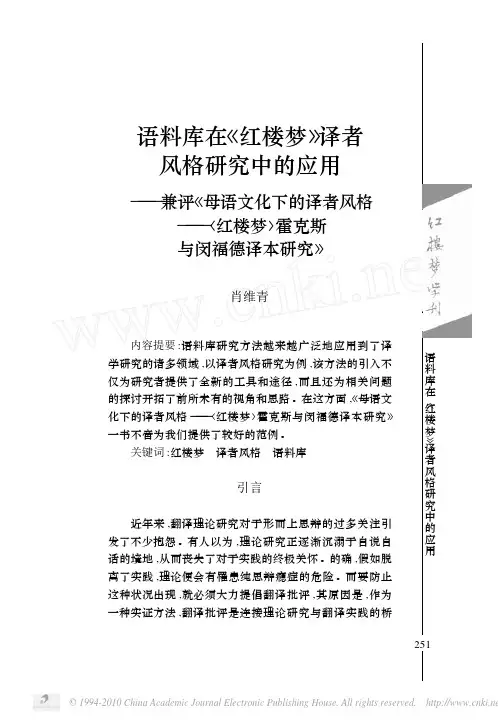
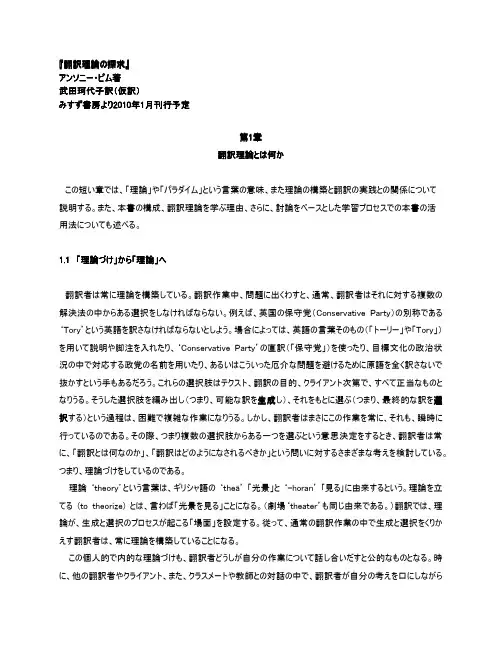
『翻訳理論翻訳理論のの探求探求』』アンソニー・ピムアンソニー・ピム著著武田珂代子訳武田珂代子訳((仮訳仮訳))みすず書房書房よより20102010年年1月刊行予定刊行予定第1章翻訳理論翻訳理論とはとはとは何何かこの短い章では、「理論」や「パラダイム」という言葉の意味、また理論の構築と翻訳の実践との関係について説明する。
また、本書の構成、翻訳理論を学ぶ理由、さらに、討論をベースとした学習プロセスでの本書の活用法についても述べる。
1.11.1 「理論理論づけづけづけ」」からから「「理論理論」」へ翻訳者は常に理論を構築している。
翻訳作業中、問題に出くわすと、通常、翻訳者はそれに対する複数の解決法の中からある選択をしなければならない。
例えば、英国の保守党(Conservative Party)の別称である‘Tory’という英語を訳さなければならないとしよう。
場合によっては、英語の言葉そのもの(「トーリー」や「Tory」)を用いて説明や脚注を入れたり、‘Conservative Party’の直訳(「保守党」)を使ったり、目標文化の政治状況の中で対応する政党の名前を用いたり、あるいはこういった厄介な問題を避けるために原語を全く訳さないで抜かすという手もあるだろう。
これらの選択肢はテクスト、翻訳の目的、クライアント次第で、すべて正当なものとなりうる。
そうした選択肢を編み出し(つまり、可能な訳を生成生成生成し)、それをもとに選ぶ(つまり、最終的な訳を選選択する)という過程は、困難で複雑な作業になりうる。
しかし、翻訳者はまさにこの作業を常に、それも、瞬時に行っているのである。
その際、つまり複数の選択肢からある一つを選ぶという意思決定をするとき、翻訳者は常に、「翻訳とは何なのか」、「翻訳はどのようになされるべきか」という問いに対するさまざまな考えを検討している。
つまり、理論づけをしているのである。
理論 ‘theory’という言葉は、ギリシャ語の ‘theā’ 「光景」と ‘–horan’ 「見る」に由来するという。
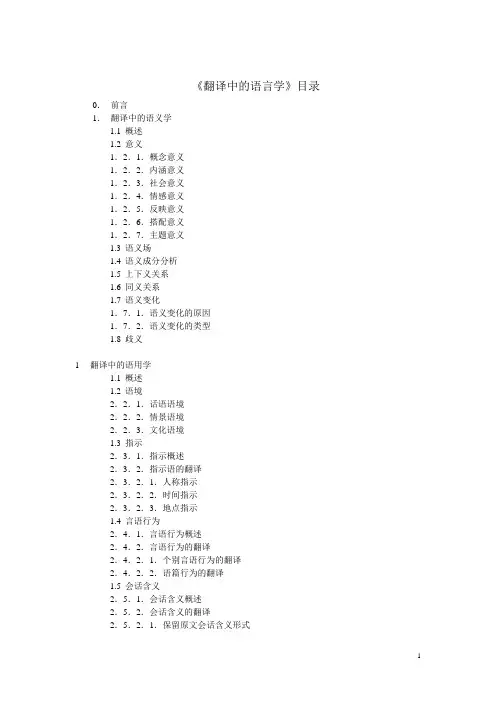
《翻译中的语言学》目录0.前言1.翻译中的语义学1.1概述1.2意义1.2.1.概念意义1.2.2.内涵意义1.2.3.社会意义1.2.4.情感意义1.2.5.反映意义1.2.6.搭配意义1.2.7.主题意义1.3语义场1.4语义成分分析1.5上下义关系1.6同义关系1.7语义变化1.7.1.语义变化的原因1.7.2.语义变化的类型1.8歧义1翻译中的语用学1.1概述1.2语境2.2.1.话语语境2.2.2.情景语境2.2.3.文化语境1.3指示2.3.1.指示概述2.3.2.指示语的翻译2.3.2.1.人称指示2.3.2.2.时间指示2.3.2.3.地点指示1.4言语行为2.4.1.言语行为概述2.4.2.言语行为的翻译2.4.2.1.个别言语行为的翻译2.4.2.2.语篇行为的翻译1.5会话含义2.5.1.会话含义概述2.5.2.会话含义的翻译2.5.2.1.保留原文会话含义形式2.5.2.2.显明原文的会话含义2.5.2.3.对译文中新产生的会话含义的处理2.5.2.4.用新的会话含义替代原文中的会话含义2.5.2.5.避免对会话含义作不必要的增补1.6礼貌原则2.6.1.礼貌原则概述2.6.2.礼貌原则的翻译2.6.2.1.按照目的语习惯表达礼貌原则2.6.2.2.保持原文和译文间的礼貌程度对等1.7前提2.7.1.前提概述2.7.2.前提的翻译2.7.2.1.涉及语言内部前提的翻译2.7.2.2.涉及语言外部前提的翻译1.8顺应论2.8.1.顺应论概述2.8.2.顺应论与翻译2.8.2.1.语境关系顺应2.8.2.2.语言结构顺应2.8.2.3.顺应的动态性2.8.2.4.顺应过程的意识程度2.9.关联理论2.9.1.关联理论概述2.9.2.关联理论对翻译的启示2.9.2.1.翻译是一种明示-推理性质的交际行为2.9.2.2.翻译的最根本目的是传递交际意图2.9.2.3.关联理论的“直接翻译”和“间接翻译”概念3.翻译中的句法学3.1概述3.2英汉语基本句型3.3英汉语句法结构差异及翻译中的句式转换3.3.1.形合与意合3.3.2.主动与被动3.3.3.静态与动态3.3.4.话题-评论与主语-谓语3.3.5.有灵主语与无灵主语4。
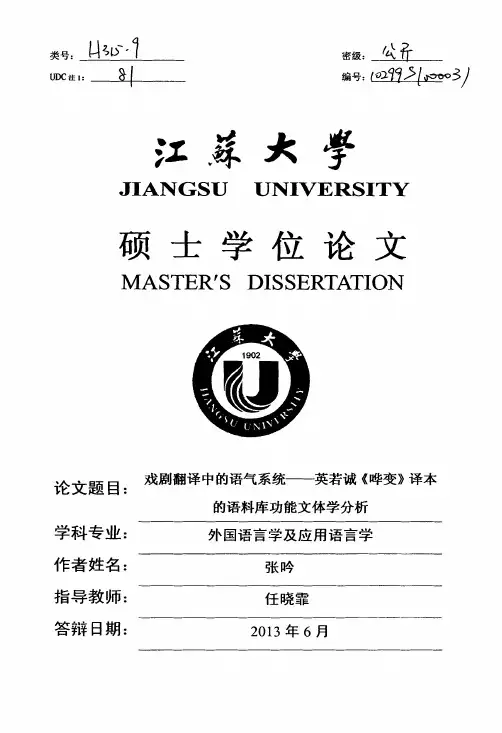
Withthehelpofcorpns-basedapproach,weacquirethedistributionsofvariousexpressionsofmoodsysteminthefamousplayThe“Caine’’MutinyCourt-MartialwrittenbyHermanWoukanditsChineseversion《哗变》translatedbyYingRuocheng.Thecorpus-basedapproachpossessesthefeaturesofvisualizationandobjectivity,beingaperfectpromotionofthestudyofthetranslator’Sstyle.Infunctionalstylistics,moodandmodalitysystemaretheprimarymeanstorealizeinterpersonalfunction.ThisthesisattemptstostudythereconstructionoftheinteractiverelationshipsbetweenQueegandMaryk,thetwomajorcharactersandtheirinterpersonalrelationshipsindramatranslations.TheresearchfindingsshowthesysteminEnglish-Chinesedramatranslations.Throughthepatternsofmoodcorpus—basedstylisticanalysisofmoodsysteminthetranslationofThe“Cable’’MutinyCourt-Martial,weattempttoexplorearesearchpatternofcorpusfunctionaldramatranslationstudies.stylisticsin1.2MethodologyofthePresentStudyInthisthesis,therewillbeacombinationofempiricalcorpusapproachandquantitativeanalysis.AstOthequalitativeanalysis,ithasbeenconductedbytheinterpersonalfunctionraisedbyM.A.K.Hallidayinordertoprovideatheoreticalframeworktodescribeandinterpretthechosenspeeches.Inaddition,thecorpus-basedanalysisarecarriedoutbytheaidofsoftwaretoolsincludingAntconc3.2.1,ICTCLAS,TextPreProcessingandConcordance3.0.CorpusLinguisticsisaresearchmethodprovidingthepossibilitytoobservetheactualusageoflanguagebycollectingandusinglargecorporatostudylexico—grammar,semanticsaswellasdiscourse,offeringstrongtheoryandtechnicalsupportforrelativeresearches.Corpus-basedapproach,pioneeredbyLeech,Canmaketheexplorationoflanguagesufficientandpowerful,Leech(1992:106)pointsoutthat,”Corpuslinguisticsdefinesnotjustanewlyemergingmethodologyforstudyinglanguage,butflnewresearchenterprise,andinfactanewphilosophicalapproachtothesubject.”Corpus-basedapproachisdescriptiveinnature.Itis”oneofthethreebasicapproachestotheresearchofcontemporarylinguistics,togetherwiththeothertwoandelicitation”(Yang,2002:6).Svartvik(Yang,2002:9)approaches:introspectionarefamiliartoChineseaudiencesinthekeyandfuzzyplaceoftheoriginal.灿linall,YingRuocheng’Stranslationshavebeenwidelypraised.Oneaudiencehighlypraisedthat:‘‘InThe“Caine’’MutinyCourt-Martial,discourseshowsstrongpower,anditisalsothefoundationofthedrama”(Lin,1992:235).T0ngDaoming,adramacritic,pointsoutthattheSUCCESSofThe“Caine’’MutinyCourt-MartialwillbeatimelyreminderforChinesedramatist:theartisticinnovationofdramaCanbeachievednotonlybybreakingthedominanceoflinesandendowingmorebody-shapedfactorstodramaticarts,butalsobyimprovingthepotentialsofdramaticdialogues.Thatistodigdeepintheinherentterritoryoftraditionaldrama,developthecharmoflanguageandexplorenewartisticpossibilitiesofdrama(Lin,1992:236).ThisisalsothedeepmeaningoftheculturalsignificanceofYingRuocheng’Sdramatranslation.2.2TheApproachofCorpus-BasedFunctionalStylisticstoDramaTranslationStudy2.2.1DramaandDramaTranslationDramaisoneoftheformsofliteraturetoberead,judgedandperformedonthestage.Ithasalonghistory.TheancientGreekdramaCanbetracedbackto2,500yearsago,andtheChinesedramacanalsobedatedbackto12山centuryoftheSouthernSongDynastyofChinesehistory.InthebookDramaasCulturalSign,Bigsbydiscussesthatdramaisanindicatorofanation’Sculturaldevelopment.Heexplains,”Dramahasalwayshadthepowertoengagethepresentinawaythatislesstrueofothergenres.Unlikethenovelitspeaksinthepresenttense,andthesenseofsharedexperiencewhichderivesfromthismakesitasensitiveinstrumentforplottingchangesinculturalpressure,forrespondingtOchangingideological,socialandaestheticmoods.”(Bigsby,1978:340)AccordingtoZhang(2011:11),“DramaCanbedividedintotheancientdrama,medievaldrama,modemdramabythetimes;classicaldramaandanti-classicaldramafromtheperspectiveofmanifestations;tragedy,comedyandtragicomedybybroadsense;historicaldrama,religiousdrama,philosophicaldrama,fables,plays,children’SplayandSOonbysubjectmatter;exclamatoryonthebasisofsentence’Sfunction.InEnglish,subjectisthefocusofmoodsystem,anditisalsothekeyfactortodeterminethemood.Besides,subjectandplaysaveryimportantroleinEnglish,asitisresponsibleforthesuccesseffectivenessofpropositions.Thus,changesinthemoodcategoryalwaysrelatetotheemergenceofsubjectandthepositioninwhichitappears.Whenthereareadditionalquestions,thesubjectisthecomponentsresponsibleforthepropositions(Zhang,2009:3).However,inChinese,itisnolongerthemainconcern,whichistransferredtothepredicateverbreflectingtheprocessoftransitivitystnlctureandtheactionandstateofsituationalcontext,eventothewholepredicate(:/:hang,2009:4).Theabovetheoriesandideasareinstructiveforthetheoreticalframeworkofthethesis.alsomakesuseofalotofdirectspeechesinordertodescribetothejudgeQueeg’Sstrongverbalbehavioratthattime.Forexample:Thecaptainsuddenlyyelled,“We'rerunninguponthebeach!Reversecourse!Makethirtyknots!”Therefore,intermsofexclamatoryandinterrogativesentences,Queegmoreoftenrevealsthestrongemotionalreactionsinhisheart.4.3TheSystematicSurveyandFunctionalStylisticAnalysisofMoodSystemofQueegandMarykinYingRuocheng’SVersion<哗变》Asmentionedearlier,werefertopreviousstudiesonChinesemoodsystem,andchoosemodalparticle,interjections,modaladverbs,specialsyntaxformats,exclamatoryandinterrogativesentencesasthesearchingitems.Besides,weinvestigatethemoodsystemofQueegandMarykinYingRuocheng’Sversionbymakinguseofcorpussoftwares,suchasTextPreprocessing,ICTCLASandAntconc.(Thetaggingof的inICTCLASareunanimousasstructuralparticleU.Accordingtotheusageofstructuralparticles,的iscloselyfollowedbycomma,fullstopandmodalparticles.Throughtheartificialscreening,wesplitoutitsusageofmodalas的in台撼是逆时钟方向旋转的谳你还是particleandannotateYbehind.such真够精明的啊.Thefollowingtablesdisplaytheapplicationsofmodalparticle,interjections,modaladverbs,specialsyntaxformats,exclamatoryandinterrogativesentencesutilizedbyQueegandMaryk.Table9ModalParticlesUsesbyMarykandQueeginYing’SVersion语气助词玛瑞克魁格语气助词频次白.分比语气助词频次卣分比飞N60(1.033%)弋心62(0.782%)的Ⅳ29(0.499%)的Ⅳ38(0.366%)Ⅱ巴,Y12(0.207%)吧厂Y10(0.126%)啦/Y2(0.034%)呢Ⅳ8(0.101%)反复/Dl(o.017%)非常/D2(o.025%)准确/ADl(O.017%)敢巾G2(O.025%)顶多/Dl(0.017%)刚刚/D2(0.025%)慢/ADl(0.017%)实际上国2(0.025%)忽然/Dl(0.017%)一加2(0.025%)单/DGl(o.017%)有点/D2(0.025%)正ml(o.017%)越来越/D2(O.025%)一定/Dl(o.017%)曾经/D2(O.025%)净/Dl(0.017%)重新/D2(0.025%)特别/Dl(0.017%)从来不/D2(0.025%)从来/Dl(0.017%)几乎/D2(0.025%)亲自/Dl(0.017%)乱/D2(O.025%)不要/Dl(0.017%)足以/D2(0.025%)正在,Dl(0.017%)却仍2(0.025%)先/Dl(0.017%)只是/D2(0.025%)先是/Dl(0.017%)严格/AD2(0.025%)多么/D1(0.017%)很快/D1(0.013%)只/D1.(0.017%)就要/Dl(0.013%)就算/Dl(O.017%)幸好/Dl(0.013%)苦苦/Dl(0.017%)本来/Dl(0.013%)大约/Dl(O.017%)毕竟/Dl(O.013%)的确/D1(0.017%)遍地^D1(0.013%)偷偷/Dl(O.017%)不必/Dl(0.013%)只是,Dl(O.017%)不至丁仍l(0.013%)就要/Dl(0.017%)彻底/ADl(0.013%)其实/Dl(0.017%)人致/Dl(0.Ol3%)也许/Dl(0.017%)反止/Dl(0.013%)一直/Dl(O.017%)恨不得/Dl(O.013%)interrogativesentence.ItcallbeinferredthatY'mgRu0Chengconsideringthecharacters’personalitiesandstatushighlightsQueeg’Sauthorityandstraightforwardbyaddinginterrogativeandexclamatorysentencestostrengthenhismoods.Tosumup,withregardtotheobviousdifferencesbetweenthetwocharactersintheoriginaltext,therearemanyconfusingpointsinthereconstructionofnleirpersonalitiesandinterpersonalrelationshipsinthetranslation.Intheoriginaltext,Queeg,whoistheaccuserandthesuperior,isopenandaboveboardwithaclearconscience.Sohisspeechwimanimposingimpactsharplycontrastswithhisopponent.WhileMaryk,whoisthedefendantandthesubordinate,mainlyadoptsthetacticsofplayingschemingandkillingwithkindness.Inthetranslation,Maryk’Ssuperficialsoftnessandpassivenessseemtobeweakened.Then,istherealeffectofthedramaticdiscourseshifted?IftheanSWerisyes,howisthedramaticeffectthen?Allthesedeserveourfurtherattention.4.3.1ModalParticlesModalparticlelike的、7、昵、吗、吧、啊isanimportanttypeoffunctionwordsinChineseandoneofthemosteffectivemeansofmoodexpression.Theessentialemotionalmeaningstosentences.meaningofmodalparticleliesinitsabilitytoattachModalparticlecanstrengthenmoodssuchasindicativemood,interrogativemood,imperativemoodandexclamatorymoodwhenitisusedattheendorthepauseofasentence.Meanwhile,therearesubtledifferencesbetweenmodalparticleswhichCanexpressthesamemood.Theycanaccuratelyexpressthespeakers’eventhelisteners’differentattitudesaboutsentencepropositionsandevents.Thatisintersubjectivityacademia.Inaddition,theycanalsobeusedasinformationmarkersaccordingtotheanddiscoursemarkers.Ran(2004)believesthatthesewordsshouldnotbeoverlooked.Theroletheyplayinthedynamicprocessofcommunicationisfarbeyondthatofacommonwordorstructureinconventionalsense.Theirpragmaticfunctionscanonlybedeterminedbycontext.Indramadialogues,modalparticlesownthefeaturesofenhancingcolloquial,showingthespeakers’characteristicsandtheirpowerandstatus,aswellasconveyingthespeakers’subjectiveemotionsandmentalstatesinparticularsituations.Wehave。
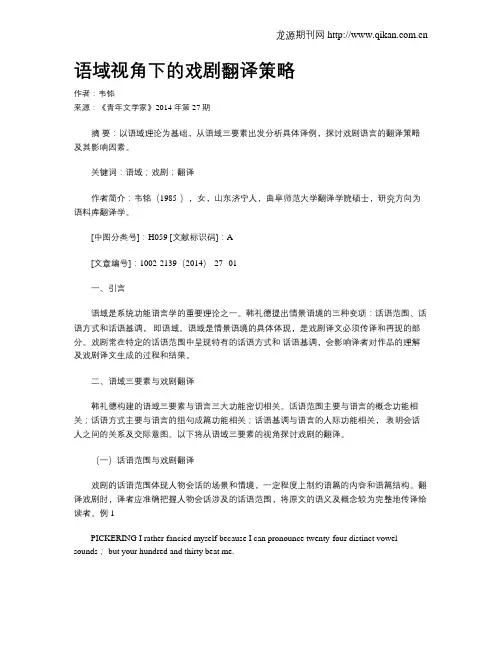
语域视角下的戏剧翻译策略作者:韦铭来源:《青年文学家》2014年第27期摘要:以语域理论为基础,从语域三要素出发分析具体译例,探讨戏剧语言的翻译策略及其影响因素。
关键词:语域;戏剧;翻译作者简介:韦铭(1985-),女,山东济宁人,曲阜师范大学翻译学院硕士,研究方向为语料库翻译学。
[中图分类号]:H059 [文献标识码]:A[文章编号]:1002-2139(2014)-27--01一、引言语域是系统功能语言学的重要理论之一。
韩礼德提出情景语境的三种变项:话语范围、话语方式和话语基调,即语域。
语域是情景语境的具体体现,是戏剧译文必须传译和再现的部分。
戏剧常在特定的话语范围中呈现特有的话语方式和话语基调,会影响译者对作品的理解及戏剧译文生成的过程和结果。
二、语域三要素与戏剧翻译韩礼德构建的语域三要素与语言三大功能密切相关。
话语范围主要与语言的概念功能相关;话语方式主要与语言的组句成篇功能相关;话语基调与语言的人际功能相关,表明会话人之间的关系及交际意图。
以下将从语域三要素的视角探讨戏剧的翻译。
(一)话语范围与戏剧翻译戏剧的话语范围体现人物会话的场景和情境,一定程度上制约语篇的内容和语篇结构。
翻译戏剧时,译者应准确把握人物会话涉及的话语范围,将原文的语义及概念较为完整地传译给读者。
例1PICKERING I rather fancied myself because I can pronounce twenty-four distinct vowel sounds; but your hundred and thirty beat me.HIGGINS but you keep on listening,and presently you find they’re all as different as A from B.《卖花女》杨宪益译辟克林我自己念得出二十四个不同的元音,觉得已经不算坏了;可是你却能分别出一百三十个元音,比我高明多了。
学术硕士/翻译硕士翻译理论研究阅读书目贝尔.《翻译与翻译过程:理论与实践》[M].(秦洪武译)北京:外语教学与研究出版社,2005.曹明伦.《翻译之道:理论与实践》[M].保定:河北大学出版社,2007.陈德鸿、张南峰.《西方翻译理论精选》[C]. 香港:香港城市大学出版社,2000. 陈福康.《中国译学理论史稿》[M].上海:上海外语教育出版社,1992.陈志杰.《文言语体与文学翻译——文言在外汉翻译中的适用性研究》[M].上海:上海外语教育出版社,2009.程雨民.《英语语体学》[M].上海:上海外语教育出版社,2004.董乐山等.《第三帝国的灭亡》(William L.Shirer著)[Z].北京:中国对外翻译出版公司,1983.董史良.翻译的思维问题[J].《中国翻译》,1988,(3).28-31.冯国华、吴群.《英译汉别裁》[M].北京:外文出版社,2000.冯庆华.《实用翻译教程》[M].上海:上海译文出版社,2000.冯庆华.《实用翻译教程》[M].上海:上海外语教育出版社,2007.冯树鉴.《实用英汉翻译技巧》[M].上海: 同济大学出版社,1995.高健.《翻译与鉴赏》[M].北京:外语教学与研究出版社,2006.高名凯、刘正埮.《现代汉语外来词研究》[M].北京:文字改革出版社,1958.龚光明.《翻译思维学》[M].上海:上海社会科学院出版社,2004.辜正坤.《译学津原》[M].郑州:文心出版社,2005.辜正坤.《中西诗比较鉴赏与翻译理论》[M].北京:清华大学出版社,2003.郭建中.《翻译:理论、实践与教学——郭建中翻译研究论文选》[C].杭州:浙江大学出版社,2010.郭建中.《科普与科幻翻译》[M].北京:中国对外翻译出版公司,2008.贺晓丽.从译者思维角度看翻译过程[J]. 《外语教学与研究》,2007,(33):23-25. 胡德良、孙红艳.论写作与翻译的关系[J].《小说评论》,2001,(2):277-280. 黄邦杰.《译艺谭》[M].北京:中国对外翻译出版公司,1991.金敬红、李思国.斯坦纳和勒代雷的阐释翻译理论评介[J].《外语与外语教学》,2003,(9):44-47.金隄.《等效翻译探索》[M].北京:中国对外翻译出版公司,1998.金圣华.《外文中译研究与探讨》[C].香港:香港中文大学翻译系,1998.金圣华.《因难见巧》[C]. 北京:中国对外翻译出版公司,2001.劳陇.意译论[J]. 《外国语》,1996,(4):13-15.劳陇.试论现代翻译理论研究的探索途径[J].《外国语》,1994,(4):5-6.劳陇.从奈达翻译理论的发展谈直译和意译问题[J].《中国翻译》,1989,(3):10-13.劳陇.怎样发挥译文的语言优势[J].《国际关系学院》,1983,(1):74-77.勒代雷.《释意学派口笔译理论》[M].(刘和平译).北京:中国对外翻译出版公司,2001.李长栓.《非文学翻译理论与实践》[M].北京:中国对外翻译出版公司,2004. 李长栓.《非文学翻译》[M]. 北京:外语教学与研究出版社,2009.李文革.《西方翻译理论流派研究》[M].北京:中国社会科学出版社,2004.李运兴.《英汉语篇翻译》[M].北京:清华大学出版社,1998.连淑能.《英汉对比研究》[M].北京:高等教育出版社,1993.刘法公.汉英隐喻翻译中的喻体意象转换[J].《中国翻译》,2007,(6): 47-51. 刘宓庆.《现代翻译理论》[M]. 济南:山东文艺出版社,1990.罗新璋.《翻译论集》[C]. 北京:商务印书馆,2009.罗新璋.释“译作”[A].《因难见巧》[C].北京:中国对外翻译出版公司,2001. 罗选民.论文化/语言层面的异化归化翻译[J].《外语学刊》, 2004,(1):102-106. 马红军.《翻译批评散论》[M].北京:中国对外翻译出版公司,2002.马红军.《从文学翻译到翻译文学:许渊冲的译学理论与实践》[M].上海:上海译文出版社,2006.马祖毅.《中国翻译简史》[M].北京:中国对外翻译出版公司,1984.毛荣贵.《翻译美学》[M].上海:上海交通大学出版社,2005.潘文国.“读文写白”是提高中文水平的根本途径[J].《中国外语》,2010,(4):33-34.钱钟书.《谈艺录》[M].上海:中华书局,1979.沈苏儒.《论信达雅——严复翻译理论研究》[M].北京:商务印书馆,1998.思果.《阿丽思漫游奇境记:选评》[Z].北京:中国对外翻译出版公司,2004. 思果.《译道探微》[M].北京:中国对外翻译出版公司,2002.思果.《翻译研究》[M].北京:中国对外翻译出版社,2001.思果.《翻译新究》[M].北京:中国对外翻译出版公司,2001.苏福忠.《译事余墨》[M].北京:生活·读书·新知三联书店,2006.孙迎春.《张若谷翻译艺术研究》[M].北京:中国对外翻译出版公司,2004.孙致礼.《翻译:理论与实践探索》[M].南京:译林出版社,1999.孙致礼.评《名利场》中译本的语言特色[J].《中国翻译》,1984,(1):37-41. 谭载喜.《西方翻译简史》[M].北京:商务印书馆,2008.谭载喜.《奈达论翻译》[Z].北京:中国对外翻译出版公司,1999.王秉钦.《中国翻译思想史》[M].天津:南开大学出版社,2004.王丹阳.《文学翻译中的创作论》[M].南京:南京师范大学出版社,2009.王宏印.《文学翻译批评论稿》[M].上海:上海外语教育出版社,2006.王宏印.《文学翻译批评概论》[M].北京:中国人民大学出版社,2009.王宁.生态文学与生态翻译学:结构与建构[J].《中国翻译》,2011,(2):10-15. 王宁.《文化翻译与经典阐释》[M].北京:中华书局,2006.王寿兰.《当代文学翻译百家谈》[C].北京:北京大学出版社,1989.翁显良.意态由来画不成[M].北京:中国对外翻译出版公司,1983.夏德勇、杨锋.《当代大学写作》[M].广州:暨南大学出版社,2007.谢天振.《译介学导论》[M].北京:北京大学出版社,2007.谢天振.国内翻译界在翻译研究和翻译理论认识上的误区[J].《中国翻译》,(4):2-5.许渊冲.《翻译的艺术》[M].北京:中国对外翻译出版公司,1984.许渊冲.译学要敢为天下先[J].《中国翻译》,1999,(2):4-9.许渊冲.新世纪的新译论[J].《中国翻译》,2000,(3):2-5.许渊冲.文学与翻译[M].北京:北京大学出版社,2003.颜林海.翻译认知心理学[M].北京:科学出版社,2008.杨士焯.《英汉翻译教程》[M](第二版).北京:北京大学出版社,2011.杨士焯.翻译教材编写方法探索[J].《厦门大学学报》(哲社)教学研究专辑,2008:85-88.杨士焯.简论翻译写作学的建构[J].《写作学》(高级版),2008,(3):19-20. 杨士焯.《英汉翻译教程》[M].北京:北京大学出版社,2006.杨士焯.发挥译文的语言优势——谈文言文词语、句法在译文中的妙用[J].《上海科技翻译》,2002,(1):23-26.杨士焯.英语专业三年级学生如何提高英汉翻译技能[J].《中国翻译》,2002,(6):55-56.杨士焯.从一篇翻译看英语专业三年级学生的翻译问题[J].《中国翻译》,2000,(3):30-34.杨士焯.彼得·纽马克翻译新观念概述[J].《中国翻译》,1998,(1):48-50. 83-89.余光中.《余光中谈翻译》[M].北京:中国对外翻译出版公司,2002.张谷若.地道的原文,地道的译文[J].《翻译通讯》,1980,(1):19-23.张美芳.《中国英汉翻译教材研究》[M].上海:上海外语教育出版社,2001.张美芳.罗杰·贝尔的语言学翻译研究视角[J].《外语与翻译》,2001,(3)11-16. 赵彦春.《翻译学归结论》[M].上海:上海外语教育出版社,2005.郑海凌.《译理浅说》[M].郑州:文心出版社,2005.郑延国.《翻译方圆》[M].上海:复旦大学出版社,2009.周姬昌.《写作学高级教程》[M].武汉:武汉大学出版社,1989.Bell, Roger T.Translation and Translating: Theory and Practice [M]. Beijing: Foreign Language Teaching and Research Press, 2001.Catford, John C. A Linguistic Theory of Translation: An Essay on Applied Linguistics[M]. London: Oxford University Press, 1965.Chesterman, Andrew. Readings in Translation Theory[M]. Helsinki: Oy Finn Lectura Ab, 1989.Delisle, Jean. Translation: An Interpretive Approach[M]. Ottawa: University of Ottawa Press, 1988.Munday, Jeremy. Introducing Translation Studies [M]. London: Routledge, 2001.Newmark, P.A Textbook of Translation[M].Shanghai: Shanghai Foreign Language Education Press, 2001.Newmark, P. Approaches to Translation[M]. Shanghai: Shanghai Foreign Language Education Press, 2001.Nida, Eugene. Language, Culture, and Translating[M]. Shanghai Foreign Language Education Press, 1991.Nida, Eugene A. & Taber, C. R. The Theory and Practice of Translation [M]. Leiden, Brill, 1969.Nord, Christiane.Translating as a Purposeful Activity[M]. Shanghai Foreign Language Education Press, 2001.Savory, Theodore. The Art of Translation [M]. London: Cape, 1957.Shttleworth, Mark & Cowie, Moira. Dictionary of Translation Studies[Z]. Shanghai Foreign Language Education Press, 2004.Tytler, A. F. Essay on the Principles of Translation[M]. London: Dent, 1790. Vermeer, Hans J. Skopos and Commission in Translational Action[M]. London: Routledge, 1998.。
翻译研究资料汇总翻译研究资料汇总翻译期刊国际翻译期刊(可在proquest、EBSCO等数据库检索)International Journal of Translation (IJT)Language InternationalMachine TranslationMetaMultilingual Communications and ComputingTarget: International Journal of Translation StudiesTranslation JournalTranslation ReviewThe Translator国内翻译期刊(可在中国期刊网检索)中国翻译上海科技翻译上海翻译中国科技翻译外语与翻译外国传统翻译理论Cicero: On the Best Style of OratorsHorace: The Art of PoetryQuintilian: Insitutio OratoriaSt Jerome: Letter to PammachiusSt AugustineMartin Luther: An Open Letter on TranslatingJohn Dryden: Preface to Ovid's Epistles, Translated by Several Hands Perrot d'Ablancourt: Prefaces to Tacitus and Lucian Charles BatteuxAlexander Fraser TytlerNovalis: BlutenstaubM. V. LomonosovA. PushkinV. A. ZhukovskyV. G. BelinskyMatthew ArnoldFrancis NewmanSchlegel: Homers Werke von J.H. V ossJohann Wolfgang von Goethe: Dichtung und WahrheitFriedrich Schleiermacher: "On the Different Methods of Translating"Wilhelm von Humboldt中国传统翻译理论Chinese Translation Theory支谦:法句经序道安:五失本、三不易鸠摩罗什:嚼饭与人慧远:文不害意彦琮:十条八备玄奘:五種不翻周敦义:翻译名义序严复:译事之难鲁迅:寧信而不順傅雷钱钟书当代翻译理论Benedetto CroceWalter Benjamin: The Task of the TranslatorJ. P. PostgateK. I. ChukovskyThe American Translation WorkshopI. A. RichardsJonans ZdanysEzra Pound: Guido's RelationsFrederic WillThe Science of TranslationNoam ChomskyJ. C. CatfordEugene A. Nida: Principles of Correspondence; T oward a Science of TranslatingWolfram WilssAlbrecht NeubertKaharina Reiss: Type, Kind and Individuality of Text: Decision Making in Translation Hans J. Vermeer: Skopos and Commission in Translation TheoryMary Snell-HornbyEarly Translation StudiesJiri LevyFrantisek MikoAnton PopovicJ. S. Holmes: The Name and Nature of Translation StudiesAndré Lefevere: Mother's Courage Cucumbers: Text, System and Refraction in a Theory of LiteratureR. Van den BroeckSusan BassnettPolysystem TheoryTurij TynjanovItama Even-Zohar: The Position of Translated Literature within the Literary PolysystemGideo Toury: The Nature and Role of TranslationDeconstructionMichel FoucaultMartin HeideggerJacques Derrida: What is a "Relevant" Translation?Gayatri Spivak: The Politics of TranslationWillard V. Quine: Word and ObjectJorge Luis Borges: The Translators of The One Thousand and One NightsVladimir Nabokov: Problems of Translation: Onegin in EnglishJean-Paul Vinay and Jean Darbelnet: A Methodology for TranslationRoman Jakobson: On Linguistic Aspects of Translation 1960s-1970sPeter Newmark: Textbook of Translation; Approaches to TranslationGeorge Steiner: The Hermeneutic Motion; After Babel;L. BarkhudarovV. KomissarovGeorge MouninDanica SeleskovitchPhilip E. Lewis: The Measutre of Translation EffectsAntoine Berman: Translation and the Trials of the ForeignShoshana Blum-Kulka: Shifts of Cohesion and Coherence in TranslationLori Chamberlain: Genders and the Metaphorics of Translation 1990s and BeyondAnnie Brisset: The Search for a Native Langauge: Translation and Cultural IdentityDouglas Robinson: Western Translation TheoryLawrence Venuti: Translation Studies Reader我国翻译研究书目包惠南.文化语境与语言翻译.北京:中国对外翻译出版公司,2001.350页.鲍刚.口译理论概述.北京:中国对外翻译出版公司,2005.343页.北京第二外国语学院本书编委会编.语言与翻译(论文集) .北京:旅游教育出版社,1992.蔡小红.口译评估.北京:中国对外翻译出版公司,2007.266页.蔡新乐.翻译的艺术哲学——文学翻译的含意本体论.开封:河南大学出版社,1999.蔡新乐.文学翻译的艺术哲学.开封:河南大学出版社,2001.蔡新乐.翻译的本体论研究——翻译研究的第三条道路、主体间性与人的元翻译构成.上海:上海译文出版社,2005.284页.蔡新乐.翻译与汉语——解构主义视角下的译学研究.北京:中央编译出版社,2006.255页.蔡新乐.相关的相关:德里达“…相关的?翻译”思想及其他.北京:中国社会科学出版社,2007.305页.蔡新乐,郁东占.文学翻译的释义学原理.开封:河南大学出版社,1997.曹菡艾,赵兴民.联合国文件翻译.北京:中国对外翻译出版公司,2007.曹明伦.翻译之道:理论与实践.河北保定:河北大学出版社,2007.289页.曹汀.关于翻译标准的几个问题.北京:商务印书馆,1959.曹炜等.文言文今译方法和规律.南京:江苏教育出版社,1994.柴明颎主编.口译的专业化道路:国际经验和中国实践(论文集,英文、中文).上海:上海外语教育出版社,2006.458页.柴秀娟.翻译描述中的语域: 英汉虚构类翻译平行语篇的语域分析模式(英文本).北京:社会科学文献出版社,2007.陈福康.中国译学理论史稿.上海:上海外语教育出版社,1992/2000.521页/527页.陈菁.口译交际过程中的跨文化噪音.北京:外文出版社,2005.陈历明.翻译:作为复调的对话.成都:四川大学出版社,2006.180页.陈明瑶,卢彩虹.新闻英语语体与翻译研究.北京:国防工业出版社,2006.234页.陈蒲清.文言今译学.长沙:岳麓书社,1999/2000.陈伟.学理反思与策略重构——英汉词典中例证翻译的目的性研究.上海:上海译文出版社,2006.417页.陈伟.翻译与词典间性研究.上海:上海译文出版社,2007.427页.陈秀等编.浙江省译家研究.杭州:浙江大学出版社,2007.217页.陈玉刚主编.中国翻译文学史稿.北京:中国对外翻译出版公司,1989.陈肇雄主编.机器翻译研究进展.北京:电子工业出版社,1992.成昭伟.文学翻译概论(英文本).北京:国防工业出版社,2007. 418页.程永生.描写交际翻译学.合肥:安徽大学出版社,2001.445页.程镇球.翻译论文集.北京:外语教学与研究出版社,2002.214页.褚东伟.商业翻译导论.武汉:湖北教育出版社,2003.268页.丛滋杭.中国古典诗歌英译理论研究.北京:国防工业出版社,2007.254页.崔长青,张碧竹编.翻译的要素.苏州:苏州大学出版社,2007.党金学.中外翻译理论选读.西安:陕西人民出版社,2005.董乐山.董乐山文集(第二卷).李辉编.石家庄:河北教育出版社,2001.324页.董明.翻译:创造性叛逆.北京:中央编译出版社,2006 .217页.杜承南,文军主编.中国当代翻译百论.重庆:重庆大学出版社,1994.杜建慧等.翻译学概论.北京:民族出版社,1998.330页.杜瑞清,党金学主编.西安外国语学院学术论丛(第六卷)——翻译的艺术.西安:陕西人民出版社,2002.段初发.文学与翻译论稿.北京:中国传媒大学出版社,2005.257页.顿官刚.湖湘译林与外国翻译研究.长沙:岳麓书社,2006.范守义.翻译研究:另类视野.北京:外语教学与研究出版社,2004.566页.范祥涛.科学翻译影响下的文化变迁——20世纪初科学翻译的描写研究.上海:上海译文出版社,2006.372页.方华文.20世纪中国翻译史.西安:西北大学出版社,2005.651页.方梦之编选.译论纵横.上海:上海远东出版社,1993.334页.费小平.翻译的政治——翻译研究与文化研究.北京:中国社会科学出版社,2005.350页.冯建文.神似翻译学.兰州:敦煌文艺出版社,2001.冯庆华主编.文体翻译论.上海:上海外语教育出版社,2002.483页.冯庆华主编.红译艺坛——《红楼梦》翻译艺术研究.上海:上海外语教育出版社,2006.487页.冯庆华.母语文化下的译者风格.上海:上海外语教育出版社,2008.476页.冯文坤.翻译与翻译之存在——关于翻译的存在论思考.成都:四川人民出版社,2008.冯志伟.自然语言机器翻译新论.北京:语文出版社,1995.冯志伟.机器翻译研究.北京:中国对外翻译出版公司,2004.841页.冯志伟,杨平.自动翻译.上海:知识出版社,1987.佛雏.王国维哲学译稿研究.北京:社会科学文献出版社,2006.282页.傅浩.说诗解译:中外诗歌与翻译论集.北京:中国传媒大学出版社,2005.傅勇林.文化范式:译学研究与比较文学.成都:西南交通大学出版社,2000.傅仲选.实用翻译美学.上海:上海外语教育出版社,1993.247页.高华丽.翻译教学研究:理论与实践.杭州:浙江大学出版社,2008.254页.高黎平.美国传教士与晚清翻译.天津:百花文艺出版社,2006.高圣兵.Logic汉译研究——跨文化翻译中的“格义”、视域融合与接受.上海:上海译文出版社,2008.313页.葛校琴.后现代语境下的译者主体性研究.上海:上海译文出版社,2006.279页.耿龙明主编.翻译论丛.上海:上海外语教育出版社,1998.龚光明.翻译思维学.北京:上海社会科学院出版社,2004.485页.辜正坤.中西诗鉴赏与翻译.长沙:湖南人民出版社,1998.448页.辜正坤.中西诗比较鉴赏与翻译理论.北京:清华大学出版社,2003.548页.辜正坤.译学津原.郑州:文心出版社,2005.364页.顾铁军.外国新影片翻译与研究.北京:中国传媒大学出版社,2006.428页.顾正阳.古诗词曲英译论稿.上海:百家出版社,2003.316页.顾正阳.古诗词曲英译理论探索.上海:上海交通大学出版社,2004.417页.顾正阳.古诗词曲英译美学研究.上海:上海大学出版社,2006.491页.顾正阳.古诗词曲英译文化探索.上海:上海大学出版社,2007.449页.郭建中编.文化与翻译(论文集).北京:中国对外翻译出版公司,2000.440页.郭建中.当代美国翻译理论.武汉:湖北教育出版社,2000.郭建中.科普与科幻翻译:理论、技巧与实践.北京:中国对外翻译出版公司,2004.494页.郭兰英.口译与口译人才培养研究.北京:科学出版社,2007.187页.郭延礼.中国近代翻译文学概论.武汉:湖北教育出版社,1998/2005.601页/477页.郭云生.古文翻译法.合肥:安徽教育出版社,1989.郭著章等.翻译名家研究.武汉:湖北教育出版社,1999.465页岸选编.中西诗歌翻译百年论集.上海:上海外语教育出版社,2007.708页.韩江洪.严复话语系统与近代中国文化转型.上海:上海译文出版社,2006.340页.韩子满.英语方言汉译初探(英文本).开封:河南大学出版社,2004.119页.韩子满.文学翻译杂合研究.上海:上海译文出版社,2005.230页.何三宁.翻译多元论实证分析研究.北京:科学出版社,2008.238页.何元建.生成语言学背景下的汉语语法及翻译研究.北京:北京大学出版社,2007.361页.贺显斌.论权力关系对翻译的操控.厦门:厦门大学出版社,2005.贺显斌.论权力关系对翻译的操控.北京:外语教学与研究出版社,2006.黑龙江省翻译工作者协会编辑.翻译论丛.哈尔滨:黑龙江省译协,1988.侯国金.语用标记理论与应用:翻译评估的新方法(英文本).成都:四川大学出版社,2005.283页.胡翠娥.文学翻译与文化参与——晚清小说翻译的文化研究.上海:上海外语教育出版社,2007.274页.胡德香.翻译批评新思路:中西比较语境下的文化翻译批评.武汉:武汉出版社, 2006.胡庚申.翻译适应选择论.武汉:湖北教育出版社,2004.胡庚申主编.翻译与跨文化交流:转向与拓展(2005年首届海峡两岸翻译与跨文化交流研讨会论文集).上海:上海外语教育出版社,2007.450页.胡开宝.英汉词典历史文本与汉语现代化进程.上海:上海译文出版社,2005.302页.胡明亮.语篇衔接与翻译.成都:巴蜀书社,2007.239页.湖北省翻译工作者协会编.翻译论文集.武汉:湖北省翻译工作者协会,1987.湖北省译协,武汉市译协编,华先发主编.翻译与文化.武汉:湖北科学技术出版社,2000.408页.黄杲炘.英语诗汉译研究—从柔巴依到坎特伯雷.第2版.武汉:湖北教育出版社,2007.黄杲炘.英诗汉译学.上海:上海外语教育出版社,2007.353页.黄国文.翻译研究的语言学探索——古诗词英译本的语言分析.上海:上海外语教育出版社,2006.247页.黄河燕主编.机器翻译研究进展——2002年全国机器翻译研讨会论文集.北京:电子工业出版社,2002.282页.黄嘉德编.翻译论集.上海:西风出版社,1940.黄龙.翻译学(英文本) .南京:江苏教育出版社,1988.黄龙.翻译艺术教程.南京:南京大学出版社,1988.黄勤.英语新闻汉译的跨学科分析(英文本).北京:中国社会科学出版社,2007.282页.黄少政.翻译还是演绎——功能主义翻译研究.西宁:青海人民出版社,2003.457页.黄维木+梁,江弱水编选.余光中选集(第四卷:语文及翻译论集).合肥:安徽教育出版社,1999.黄雨石.英汉文学翻译探索.西安:陕西人民出版社,1988.黄振定.翻译学——艺术论与科学论的统一.长沙:湖南教育出版社,1998.黄振定.翻译学的语言哲学基础.上海:上海交通大学出版社,2007.246页.黄中习.中华对联研究与英译初探.长春:时代文艺出版社,2005.272页.黄忠廉.翻译变体研究.北京:中国对外翻译出版公司,2000.黄忠廉.翻译本质论.武汉:华中师范大学出版社,2000.233页.黄忠廉.变译理论.北京:中国对外翻译出版公司,2002.296页.黄忠廉,李亚舒.科学翻译学.北京:中国对外翻译出版公司,2004.444页.贾文波.应用翻译功能论.北京:中国对外翻译出版公司,2004.379页.贾正传.融合与超越:走向翻译辩证系统论.上海:上海译文出版社,2008.313页.姜秋霞.审美过程:文学翻译中的格式塔意象再造(英文本).北京:商务印书馆,2002.257页.姜治文,文军编.翻译批评论(论文集).重庆:重庆大学出版社,1999.605页.姜治文,文军主编.翻译标准论.成都:四川人民出版社,2000.蒋坚松.英汉对比与汉译英研究.长沙:湖南人民出版社,2002.227页.蒋坚松,黄振定主编.语言与翻译研究(论文集).北京:中国社会科学出版社,2000.417页.蒋坚松,彭利元主编.刘重德翻译思想及其他.长沙:湖南师范大学出版社,2003.蒋述卓.佛经翻译与中古文学思潮.南昌:江西人民出版社,1990.蒋骁华.符号学翻译研究——文学语言的理据及其再造(英文本).北京:外语教学与研究出版社,2003.215页.蒋翼振编.翻译学通论.上海:上海美利印刷公司印刷,商务印书馆发行,1927.234页.金惠康.跨文化交际翻译.北京:中国对外翻译出版公司,2003.402页.金惠康.跨文化交际翻译续编.北京:中国对外翻译出版公司,2004.492页.金圣华.桥畔译谈——翻译散论八十篇.北京:中国对外翻译出版公司,1997.金隄.等效翻译探索.北京:中国对外翻译出版公司,1989/1998.167页/235页.靳涵身.诗型广告翻译研究.成都:四川大学出版社,2004.402页.孔慧怡.翻译?文学?文化.北京:北京大学出版社,1999.孔慧怡编.中国翻译运动经纬论文集.北京:北京大学出版社,2000.孔慧怡,杨承淑编.亚洲翻译传统与现代动向.北京:北京大学出版社,2000.207页.黎难秋.中国科学文献翻译史稿.合肥:中国科学技术大学出版社,1993.黎难秋.中国科学翻译史料.合肥:中国科学技术大学出版社,1996.黎难秋.中国口译史.青岛:青岛出版社,2002.466页.黎难秋.中国科学翻译史.合肥:中国科学技术大学出版社,2006.650页.李宝初.日出山花红胜火:论叶君健的创作与翻译.北京:华文出版社,1997.李长栓.非文学翻译理论与实践.北京:中国对外翻译出版公司,2004.589页.李德凤等编.法律文本翻译(论文选).北京:中央编译出版社,2007.487页.李德俊.平行语料库与积极型汉英词典的研编——基于平行语料库的词典编纂系统CpsDict的研制与应用.上海:上海译文出版社,2008.250页.李河.巴别塔的重建与解构——解释学视野中的翻译问题.昆明:云南大学出版社,2005.李和庆,黄皓,薄振杰编.西方翻译研究方法论:70年代以后(英文本).北京:北京大学出版社,2005.326页.李寄.鲁迅传统汉语翻译文体论.上海:上海译文出版社,2008.226页.李逵六.口译——理论与实践、语言与交际.北京:外语教学与研究出版社,1994.李林波.中国新时期翻译研究考察:1981—2003.西安:西北工业大学出版社,2007.177页.李美.母语与翻译.上海:上海外语教育出版社,2008.368页.李明.翻译研究的社会符号学视角(英文本).武汉:武汉大学出版社,2005.李明,卢红梅.商务翻译研究.武汉:武汉大学出版社,2006.李爽学.得意忘言:翻译、文学与文化评论.北京:三联书店,2007.376页.李伟.中国近代翻译史.济南:齐鲁书社,2005.334页.李亚舒等编.科技翻译论著集萃.北京:中国科学技术出版社,1994.李亚舒等主编.科技翻译论著新萃.北京:气象出版社,2000.李亚舒,黎难秋主编.中国科学翻译史.长沙:湖南教育出版社,2000.744页.李延林等主编.英语文化翻译学教程(英文本).长沙:中南大学出版社,2003.183页.李玉良.《诗经》英译研究.济南:齐鲁书社,2007.396页.李运兴.语篇翻译引论.北京:中国对外翻译出版公司,2001.224页.李占喜.关联与顺应:翻译过程研究(英文本).北京:科学出版社,2007.196页.李照国.译海心语——中医药文化翻译别论.上海:上海中医药大学出版社,2006.李照国.译海心悟——中国古典文化翻译别论.上海:上海中医药大学出版社,2007.292页.李照国.熵化·耗散·重构——汉英翻译理法探微.上海:上海科学技术出版社,2008.352页.梁启超.梁启超全集(第七册).北京:北京出版社,1999.廖七一.当代西方翻译理论探索.南京:译林出版社,2000.327页.廖七一等.当代英国翻译理论.武汉:湖北教育出版社,2001.472页.廖七一.胡适诗歌翻译研究.北京:清华大学出版社,2006.344页.林本椿主编.福建翻译家研究.福州:福建教育出版社,2004.林本椿.福建翻译家研究.福州:福建教育出版社,2005.林相周.英汉翻译中的语法问题.福州:福建人民出版社,1979.刘法公.商贸汉英翻译专论.重庆:重庆出版社,1999.刘法公.商贸汉英翻译评论.北京:外语教学与研究出版社,2005.刘和平.口译技巧——思维科学与口译推理教学法.北京:中国对外翻译出版公司,2001.199页.刘和平.口译理论与教学.北京:中国对外翻译出版公司,2005.238页.刘华文.汉诗英译的主体审美论.上海:上海译文出版社,2005.336页.刘靖之,林戊荪,金圣华主编.翻译教学研讨会论文集.香港:香港翻译学会,2000.569页.刘宓庆.现代翻译理论.南昌:江西教育出版社,1990.301页.刘宓庆.当代翻译理论.北京:中国对外翻译出版公司,1999.刘宓庆.新编当代翻译理论.北京:中国对外翻译出版公司,2005.314页.刘宓庆.新编汉英对比与翻译.北京:中国对外翻译出版公司,2006.559页.刘宓庆.翻译美学导论.北京:中国对外翻译出版公司,2005.371页.刘宓庆.文化翻译论纲.武汉:湖北教育出版社,1999/2007.317页/288页.刘宓庆.翻译与语言哲学.北京:中国对外翻译出版公司,2001/2007.547页/536页.刘宓庆.翻译教学:实务与理论.北京:中国对外翻译出版公司,2003/2007.614页/586页.刘宓庆.口笔译理论研究.北京:中国对外翻译出版公司,2004.334页.刘宓庆.中西翻译思想比较研究.北京:中国对外翻译出版公司,2005.546页.刘宓庆.刘宓庆翻译散论.王建国编.北京:中国对外翻译出版公司,2006.457页.刘绍龙.翻译心理学.武汉:武汉大学出版社,2007.287页.刘绍龙,何家宁,王柳琪.翻译实证研究方法论.武汉:武汉大学出版社,2006.刘世聪主编.红楼译评:《红楼梦》翻译研究论文集.天津:南开大学出版社,2004.597页.刘涌泉等.机器翻译论文选辑.北京:科学技术文献出版社,1979.刘涌泉等.中国的机器翻译.北京:知识出版社,1984.刘重德.文学翻译十讲(英文本) .北京:中国对外翻译出版公司,1991.刘重德.浑金璞玉集.北京:中国对外翻译出版公司,1994.刘重德主编.三湘译论.长沙:湖南出版社,1995.刘重德.西方译论研究.北京:中国对外翻译出版公司,2003.166页.刘重德主编.英汉语比较与翻译(1).上海:上海外语教育出版社,2006.522页.刘重德主编.英汉语比较与翻译(2).上海:上海外语教育出版社,2006.458页.刘重德.翻译论稿.北京:高等教育出版社,2007.234页.刘宗和主编.论翻译教学(论文集).北京:商务印书馆,2001.460页.卢红梅.英汉语篇回指对比研究与翻译.武汉:武汉大学出版社,2006.陆文慧主编.法律翻译——从实践出发(文集).北京:法律出版社,2004.371页.吕国军.口译与口译教学研究.北京:外语教学与研究出版社,2005.吕俊.跨越文化障碍——巴比塔的重建.南京:东南大学出版社,2001.317页.吕俊,侯向群.翻译学——一个建构主义的视角.上海:上海外语教育出版社,2006.282页.马会娟.奈达翻译理论研究(英文本).北京:外语教学与研究出版社,2003.250页.罗新璋编.翻译论集.北京:商务印书馆,1984.罗选民主编.外语·翻译·文化(第二辑).长沙:湖南科学技术出版社,1999.罗选民主编.中华翻译文摘(2000卷,汉英对照) .北京:清华大学出版社,2002.281页.罗选民主编.外国文学翻译在中国.合肥:安徽文艺出版社,2003.罗选民主编.中华翻译文摘(2001年卷,汉英对照).北京:清华大学出版社,2004.230页.罗选民编.文学翻译与文学批评.北京:人民文学出版社,2005.罗选民编.语言认知与翻译研究.北京:外文出版社,2005.罗选民主编.中华翻译文摘(2002—2003卷,汉英对照) .北京:清华大学出版社,2006.448页.罗选民编.文化批评与翻译研究.北京:外文出版社,2006.罗选民,佘协斌主编.外语·翻译·文化(第一辑).长沙:湖南科学技术出版社,1997.罗选民,屠国元主编.阐释与解构:翻译研究文集.合肥:安徽文艺出版社,2003.麻争旗.影视译制概论.北京:中国传媒大学出版社,2005.329页.马爱英.中英文化翻译——当代中国文本译释个案研究(英文本).北京:科学出版社,2006.260页.马红军.翻译批评散论.北京:中国对外翻译出版公司,2000.224页.马红军.从文学翻译到翻译文学——许渊冲的译学理论与实践.上海:上海译文出版社,2006.327页.马乐梅.中文和合本圣经翻译原则之研究.西安:陕西师范大学出版社,2001.马祖毅.中国翻译简史——“五四”运动以前部分.北京:中国对外翻译出版公司,1984/1998.331页/458页.马祖毅等编.汉籍外译史.武汉:湖北教育出版社,1997.717页.马祖毅.中国翻译史(上卷,周代——清代).武汉:湖北教育出版社,1999.796页.马祖毅等.中国翻译通史(古代部分全一卷;现当代部分第一卷、第二卷、第三卷、第四卷)〈精装本〉.武汉:湖北教育出版社,2006.古代部分全一卷538页;现当代部分第一卷729页、第二卷857页、第三卷474页、第四卷411页。